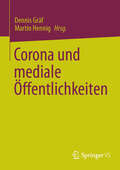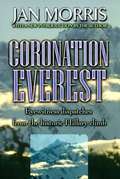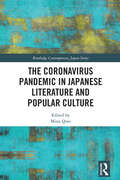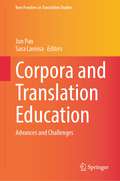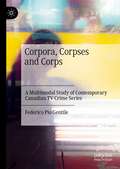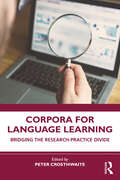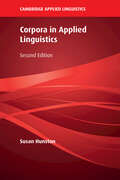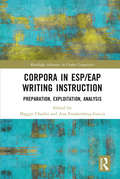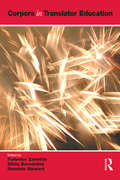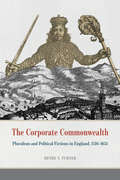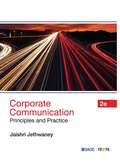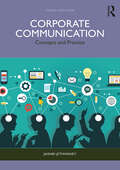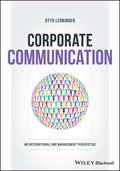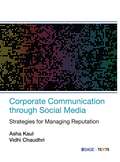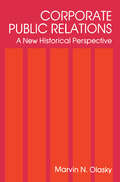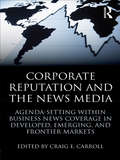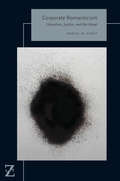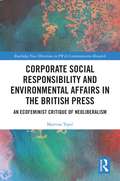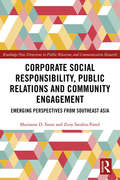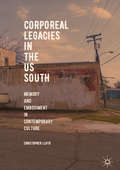- Table View
- List View
Corona und mediale Öffentlichkeiten
by Dennis Gräf Martin HennigDieses Buch bietet einen umfassenden, interdisziplinären Blick auf mediale Erscheinungsformen im Kontext der Corona-Krise und fokussiert in diesem Zusammenhang insbesondere medien- und kommunikationswissenschaftliche, linguistische und philosophische Perspektiven auf die öffentliche Kommunikation zum Themenfeld des Coronavirus. Gerade zu Beginn der Corona-Krise kam es aufgrund der aus der Neuartigkeit des Coronavirus resultierenden Ungewissheit zu signifikanten kommunikativen Störmomenten, deren Rekapitulation und Analyse für eine demokratische Gesellschaft unabdingbar sind. In diesem Sinne forscht dieses Buch nach den kommunikativen Mustern des öffentlichen Sprechens über das Coronavirus in fiktionalen sowie nicht-fiktionalen Formaten.Konkret werden im Rahmen der nicht-fiktionalen Formate TV-Nachrichtensendungen, TV-Talkshows und TV-Dokumentationen, Printnachrichten sowie Social Media-Posts analysiert. Im Rahmen der fiktionalen Formate stehen v.a. Online-Serien im Fokus des Interesses. Die unterschiedlichen, sich aus der Interdisziplinarität des Bandes ergebenden methodischen Zugänge ermöglichen einen breit gefächerten, polyperspektivischen Zugang zur Corona-Kommunikation und lassen gleichwohl (medien-)übergreifende diskursive Muster - als ein signifikantes Ergebnis des Sammelbandes - erkennen.
Coronation Everest
by Jan MorrisMay 29, 1953: Edward Hillary and Tenzing Norgay first reach the summit of Mount Everest, and nearly the Coronation Day for a new Queen, Elizabeth II. Breaking the story was James Morris, special correspondent for The Times, who met the victorious climbers at Camp IV at 20,000 feet. Morris known to millions of readers today as the travel essayist Jan Morris, wrote this account of the Hillary expedition with all the verve and sharp detail for which Jan Morris is famous.
The Coronavirus Pandemic in Japanese Literature and Popular Culture (Routledge Contemporary Japan Series)
by Mina QiaoThis volume is the first book-length collection on Japanese literary and popular cultural responses to the coronavirus pandemic in English. Disrupting the narrative of COVID-19 as a catastrophe without precedent, this book contextualizes the COVID-19 global public health crisis and pandemic-induced social and political turbulence in a post-industrial society that has withstood multiple major destructions and disasters. From published fiction by major authors to anonymous accounts on social media, from network TV shows to contents by Virtual YouTubers (VTubers), in both "high" and "low" culturescapes, timely representations of coronavirus and individual and social livings under its impact emerge. These narratives, either personal or top-down, all endeavor to fathom this unexpected disruption of modern linear progress. Exploring the paradoxes underlying the "new normal" of Japanese society of the present day, the book collectively demonstrates how the narratives of coronavirus are not "neo-" but "re-": returning to the past, revealing existing problems and reclaiming memories lost and lessons forgotten. This edited volume will be of interest to researchers and students in the fields of Japanese culture and society, Japanese literature, and pandemic studies.
Corpora and Discourse Studies
by Paul Baker Tony MceneryThe growing availability of large collections of language texts has expanded our horizons for language analysis, enabling the swift analysis of millions of words of data, aided by computational methods. This edited collection contains examples of such contemporary research which uses corpus linguistics to carry out discourse analysis. The book takes an inclusive view of the meaning of discourse, covering different text-types or modes of language, including discourse as both social practiceand as ideology or representation. Authors examine a range of spoken, written, multimodal and electronic corpora covering themes which include health, academic writing, social class, ethnicity, gender, television narrative, news, Early Modern English and political speech. The chapters showcase the variety of qualitative and quantitative tools and methods that this new generation of discourse analysts are combining together, offering a set of compelling models for future corpus-based research indiscourse.
Corpora and Translation Education: Advances and Challenges (New Frontiers in Translation Studies)
by Jun Pan Sara LaviosaThis edited book covers a range of topics related to the use of corpora in translation education, including their standing in corpus-based translation studies, their relationship with machine learning and post-editing, recent advances in learner corpora development and the integration of corpora into translation pedagogy.The book draws the reader into the latest debate on the potential benefits and challenges of using corpora in translation education, as well as serving as practical guidance on how to incorporate corpora into their teaching practice.The book is of particular interest to translation educators, researchers, and postgraduate students who are interested in exploring theoretical underpinnings as well as new ways of teaching and learning translation.
Corpora, Corpses and Corps: A Multimodal Study of Contemporary Canadian TV Crime Series
by Federico Pio GentileThis book uses corpus and multimodal methods to present a comparative study of three major Canadian TV crime series, Flashpoint (2008-2010), Motive (2013-2015) and 19-2 (2014-2016), paying special attention to cinematic techniques. Following an overview of the methodology and the Canadian cultural milieu of the study, the author approaches the three series as complex cultural and linguistic productions that depend heavily on a national appropriation of a genre whose popularity is growing internationally. The book investigates the verbal, nonverbal and paraverbal strategies employed by each production to create the patterns that make this genre appealing to a variety of audiences, and uncovers some of the psychological processes at work in contemporary Canadian TV crime serials. This book will be of interest to scholars in fields including Corpus Linguistics, Multimodal Studies, Canadian Studies, Media and Communication Studies, and Specialised Discourse.
Corpora for Language Learning: Bridging the Research-Practice Divide
by Peter CrosthwaiteThis volume presents a diverse range of expertise and practical advice on corpus-assisted language learning, bridging the gap between corpus research and actual classroom practice.Grounded in expert discussions and interviews, the book offers an extensive exploration into the intricacies of corpus-based language pedagogy, addressing its challenges, benefits, and potential drawbacks while demonstrating the power of data-driven learning (DDL) tools, including AntConc, WordSmith Tools, and CorpusMate. The book navigates the complexities of integrating DDL into mainstream educational systems, showcasing real-world applications for teaching. The authors bring together cutting-edge, international perspectives on this topic in dialogue with those using such techniques in their classroom practice.Both a rigorous academic resource and a hands-on guide for practitioners, this book is recommended reading for educators, researchers, or anyone wanting to upskill themselves in learning to harness the power of data in language pedagogy in primary, secondary, tertiary, or other professional contexts.
Corpora in Applied Linguistics (Cambridge Applied Linguistics)
by Susan HunstonCorpus Linguistics has revolutionised the world of language study and is an essential component of work in Applied Linguistics. This book, now in its second edition, provides a thorough introduction to all the key research issues in Corpus Linguistics, from the point of view of Applied Linguistics. The field has progressed a great deal since the first edition, so this edition has been completely rewritten to reflect these advances, whilst still maintaining the emphasis on hands-on corpus research of the first edition. It includes chapters on qualitative and quantitative research, applications in language teaching, discourse studies, and beyond. It also includes an extensive discussion of the place of Corpus Linguistics in linguistic theory, and provides numerous detailed examples of corpus studies throughout. Providing an accessible but thorough grounding to the fascinating, fast-moving field of Corpus Linguistics, this book is essential reading for the student and the researcher alike.
Corpora in ESP/EAP Writing Instruction: Preparation, Exploitation, Analysis (Routledge Advances in Corpus Linguistics)
by Maggie CharlesThis collection showcases the latest innovations in research on the application of corpora and corpus-based methods in ESP/EAP writing instruction and the many ways in which corpora can be successfully and practically integrated in ESP/EAP programmes. While previous work has discussed the successful use of corpora in teaching writing in the areas of ESP/EAP, this book is the first of its kind to bring the most up-to-date research on the topic together in one place. The volume’s unique structure mirrors the key stages of the writing instruction process, from preparation to exploitation to analysis. The book begins by showing how corpora can be used to prepare materials, moving into an exploration of how students in ESP/EAP programmes use corpora in practice, before bringing the discussion full circle to the ways in which corpus-based approaches might be implemented to analyse ESP/EAP student writing. This approach presents readers with insights into how corpora can be effectively integrated into ESP/EAP writing instruction at every step of the process and opens the way for future areas of study. This book will be of particular interest to students and researchers in applied corpus linguistics, English for Specific Purposes, and English for Academic Purposes, as well as active practitioners in ESP/EAP writing instruction.
Corpora in ESP/EAP Writing Instruction: Preparation, Exploitation, Analysis (Routledge Advances in Corpus Linguistics)
by Maggie CharlesThis collection showcases the latest innovations in research on the application of corpora and corpus-based methods in ESP/EAP writing instruction and the many ways in which corpora can be successfully and practically integrated in ESP/EAP programmes. While previous work has discussed the successful use of corpora in teaching writing in the areas of ESP/EAP, this book is the first of its kind to bring the most up-to-date research on the topic together in one place. The volume’s unique structure mirrors the key stages of the writing instruction process, from preparation to exploitation to analysis. The book begins by showing how corpora can be used to prepare materials, moving into an exploration of how students in ESP/EAP programmes use corpora in practice, before bringing the discussion full circle to the ways in which corpus-based approaches might be implemented to analyse ESP/EAP student writing. This approach presents readers with insights into how corpora can be effectively integrated into ESP/EAP writing instruction at every step of the process and opens the way for future areas of study.This book will be of particular interest to students and researchers in applied corpus linguistics, English for Specific Purposes, and English for Academic Purposes, as well as active practitioners in ESP/EAP writing instruction.
Corpora in Interpreting Studies: East Asian Perspectives (Routledge Studies in East Asian Interpreting)
by Cheung, Edited by Andrew K. FCheung, Liu, Moratto, and their contributors examine how corpora can be effectively harnessed to benefit interpreting practice and research in East Asian settings. In comparison to the achievements made in the field of corpus- based translation studies, the use of corpora in interpreting is not comparable in terms of scope, methods, and agenda. One of the predicaments that hampers this line of inquiry is the lack of systematic corpora to document spoken language. This issue is even more pronounced when dealing with East Asian languages such as Chinese, Japanese, and Korean, which are typologically different from European languages. As language plays a pivotal role in interpreting research, the use of corpora in interpreting within East Asian contexts has its own distinct characteristics as well as methodological constraints and concerns. However, it also generates new insights and findings that can significantly advance this research field. A valuable resource for scholars of scholars focusing on corpus interpreting, particularly those dealing with East Asian languages.
Corpora in Translator Education
by Federico Zanettin Dominic Stewart Silvia BernardiniThe use of language corpora as a resource in linguistics and language-related disciplines is now well-established. One of the many fields where the impact of corpora has been growing in recent years is translation, both at a descriptive and a practical level. The papers in this volume, which grew out of presentations at the conference Cult2k (Bertinoro, Italy, 2000), the second in the series Corpus Use and Learning to Translate, are principally concerned with the use of corpora as resources for the translator and as teaching and learning aids in the context of the translation classroom. This book offers a cross-section of research by some leading scholars in the field, who offer accounts of first-hand experience and theoretical insights into the various ways of building and using appropriate corpora in translation teaching, for the benefit of teachers and learners alike. The various contributions provide a rich source of inspiration for other researchers and practitioners concerned with 'corpora in translator education'. Contributors include Stig Johansson, Tony McEnery, Kirsten Malmkjær, Jennifer Pearson, Lynne Bowker, Krista Varantola, Belinda Maia and a number of other scholars.
Corporate Character
by Eddy KentThe vastness of Britain's nineteenth-century empire and the gap between imperial policy and colonial practice demanded an institutional culture that encouraged British administrators to identify the interests of imperial service as their own. In Corporate Character, Eddy Kent examines novels, short stories, poems, essays, memoirs, private correspondence, and parliamentary speeches related to the East India Company and its effective successor, the Indian Civil Service, to explain the origins of this imperial ethos of "virtuous service."Exploring the appointment, training, and management of Britain's overseas agents alongside the writing of public intellectuals such as Edmund Burke, Thomas Malthus, Thomas Babington Macaulay, and J.S. Mill, Kent explains the origins of the discourse of "virtuous empire" as an example of corporate culture and explores its culmination in Anglo-Indian literature like Rudyard Kipling's Kim. Challenging narratives of British imperialism that focus exclusively on race or nation, Kent's book is the first to study how corporate ways of thinking and feeling influenced British imperial life.
The Corporate Commonwealth: Pluralism and Political Fictions in England, 1516–1651
by Henry S. TurnerThe Corporate Commonwealth traces the evolution of corporations during the English Renaissance and explores the many types of corporations that once flourished. Along the way, the book offers important insights into our own definitions of fiction, politics, and value. Henry S. Turner uses the resources of economic and political history, literary analysis, and political philosophy to demonstrate how a number of English institutions with corporate associations—including universities, guilds, towns and cities, and religious groups—were gradually narrowed to the commercial, for-profit corporation we know today, and how the joint-stock corporation, in turn, became both a template for the modern state and a political force that the state could no longer contain. Through innovative readings of works by Thomas More, William Shakespeare, Francis Bacon, and Thomas Hobbes, among others, Turner tracks the corporation from the courts to the stage, from commonwealth to colony, and from the object of utopian fiction to the subject of tragic violence. A provocative look at the corporation’s peculiar character as both an institution and a person, The Corporate Commonwealth uses the past to suggest ways in which today’s corporations might be refashioned into a source of progressive and collective public action.
Corporate Communication: Principles and Practice
by Jaishri JethwaneyA comprehensive and engaging textbook that helps in understanding the underlying concepts and real-life strategies of communication in modern day corporate set-ups. A non-exhaustive list of the functions of corporate communication involves identifying and segmenting stakeholders, promoting brand positioning, selecting appropriate channels of internal and external communication, and managing crisis and reputation, among others. This second revised edition of Corporate Communications: Principles and Practice - a well-accepted textbook designed for the students of mass communication, public relations and journalism - offers a fresh perspective into all basic and critical aspects of corporate communication. It incorporates the latest changes in governmental policies and industry trends in the country to aid students relate to the contemporary environment and become industry-ready. Key Features: Incorporates the changes brought about by Companies Act 2013 (CSR practices), tax reforms by Government of India (GST in place of multiple indirect tax structure) and others Includes citations from Encyclopedia on Corporate Reputation for global perspectives on issues. New global and Indian case studies with points for discussion and analytical inputs
Corporate Communication: Concepts and Practice
by Jaishri JethwaneyCorporate Communication: Concepts and Practice—a comprehensive and engaging textbook—helps in understanding the underlying concepts and real-life strategies of communication in modern-day corporate set-ups. One of the youngest management disciplines, corporate communication is used by companies to position themselves to the outside world in a highly competitive business environment and to build a “sense of being,” on the one hand, and creating a feeling of pride in being associated with the company for various stakeholders, especially the employees and investors. Some of the functions of corporate communication include identifying and segmenting stakeholders, articulating brand positioning, selecting appropriate channels of internal and external communication, and managing crises, conflicts, and reputations, among others. This revised edition offers a fresh perspective into all basic and critical aspects of corporate communication and incorporates the latest changes in governmental policies and industry trends to aid students adapt to the contemporary business environment and become industry-ready. This book will be of great interest to students and researchers working in the areas of corporate communication, organizational communication, journalism, mass communication, communication studies, public relations, and human resource management.
Corporate Communication: An International and Management Perspective (Routledge Communication Ser.)
by Otto LerbingerProvides an international and management perspective on the field of corporate communication Corporate communication plays an important role in higher-level management to help build and preserve a company’s reputation. This intangible yet valuable asset determines the net worth of a company and affects the success of its operations. Corporate Communication: An International and Management Perspective introduces readers to the broad environment of the modern extended organization and provides an understanding of the globalization process. It describes how economic, political, and cultural features of a country affect company decisions and communication and discusses various communication disciplines and practices that are employed in programs and campaigns. This book addresses the key management issues of sustainability and technology and innovation. It also emphasizes the importance of why corporate communication must be seen as a management function and not restricted to a communication process. Presented in five parts, Corporate Communication offers comprehensive chapters covering: The Domain of Corporate Communication; Strategic Application of Communication Practices; International Perspective; Key Management Issues of Sustainability and Technology; and Corporate Communication Contribution to Management. The foundation of Corporate Communication is public relations but also included is the entire range of communication practices and the contribution to management decision making. Conceptualizes corporate communication as a strategic management function which helps management recognize, adjust to, and construct policy related to global issues Emphasizes the critical role that corporate communication plays in making corporate decisions and behaviors more socially responsible and sustainable Demonstrates how corporate communication draws on public affairs, marketing and social media in its strategic planning Emphasizes the critical importance of relationships to corporations and their effect on reputation Provides numerous examples of cases of global problems and how corporations have responded to them Corporate Communication is intended for upper-level undergraduate and graduate students in schools of communication and schools of business and management who want to extend their competence to the global arena and to combine the various communication practices to design strategic programs and campaigns. Course titles include corporate communication, international public relations, corporate public affairs, global marketing communication, global corporate communication, and social media.
Corporate Communication through Social Media: Strategies for Managing Reputation
by Asha Kaul Vidhi ChaudhriSocial media are rapidly and dramatically transforming the communication landscape. They are purported to provide reputational benefits by promoting transparency and enhancing possibilities for stakeholder engagement. However, they also present reputational risks by exposing organizations to new types of crises, stakeholder criticism, and digital activism. This textbook provides a comprehensive look at social-mediated developments in corporate and organizational communication and examines the consequent implications for reputation management. The book takes a grounded approach in bringing together perspectives from communication and management and from scholarship and practice. It helps the reader make sense of digitalization in corporate communication and its consequences for organization - stakeholder relationships, trust, engagement, leadership, and reputation. Covering a wide spectrum of topics such as branding, consumer engagement, employee relations, crisis communication, corporate responsibility and sustainability, and the return on investment (ROI), the book maps key changes in the evolving communication landscape, with an understanding of the strategic benefits and challenges for corporate reputation. Key Features • Blend of theory and practice of social-mediated communication and implications for reputation management • International focus with contemporary (and classic) examples and cases • Link with professional practice in "Voices from the Field" feature • Discussion questions and activities to encourage critical reflection and informed application
Corporate Public Relations: A New Historical Perspective (Routledge Communication Series)
by Marvin N. OlaskyThis volume presents a historical and objective overview of the field of public relations in the past century. It discusses some of the landmark cases in public relations, critiques the philosophies of innovators such as Ivy Lee and Edward Bernays, and explores how corporate public relations has affected economic and political trends. The author concludes by offering long-term alternatives for the future of public relations valuable to both practitioners and corporate executives.
Corporate Reputation and the News Media: Agenda-setting within Business News Coverage in Developed, Emerging, and Frontier Markets (Routledge Communication Series)
by Craig E. CarrollThis volume examines agenda-setting theory as it applies to the news media’s influence on corporate reputation. It presents interdisciplinary, international, and empirical investigations examining the relationship between corporate reputation and the news media throughout the world. Providing coverage of more than twenty-five countries, contributors write about their local media and business communities, representing developed, emerging, and frontier markets – including Argentina, Brazil, Chile, China, Germany, Greece, Japan, Nigeria, Spain, and Turkey, among others. The chapters present primary and secondary research on various geo-political issues, the nature of the news media, the practice of public relations, and the role of public relations agencies in each of the various countries. Each chapter is structured to consider two to three hypotheses in the country under discussion, including: the impact of media visibility on organizational prominence, top-of-mind awareness and brand-name recognition the impact of media favorability on the public’s organizational images of these firms how media coverage of specific public issues and news topics relates to the associations people form of specific firms. Contributors contextualize their findings in light of the geopolitical environment of their home countries, the nature of their media systems, and the relationship between business and the news media within their countries’ borders. Incorporating scholarship from a broad range of disciplines, including advertising, strategic management, business, political communication, and sociology, this volume has much to offer scholars and students examining business and the news media.
Corporate Romanticism: Liberalism, Justice, and the Novel (Lit Z)
by Daniel M. StoutCorporate Romanticism offers an alternative history of the connections between modernity, individualism, and the novel. In early nineteenth-century England, two developments—the rise of corporate persons and the expanded scale of industrial action—undermined the basic assumption underpinning both liberalism and the law: that individual human persons can be meaningfully correlated with specific actions and particular effects. Reading works by Godwin, Austen, Hogg, Mary Shelley, and Dickens alongside a wide-ranging set of debates in nineteenth-century law and Romantic politics and aesthetics, Daniel Stout argues that the novel, a literary form long understood as a reflection of individualism’s ideological ascent, in fact registered the fragile fictionality of accountable individuals in a period defined by corporate actors and expansively entangled fields of action.Examining how liberalism, the law, and the novel all wrestled with the moral implications of a highly collectivized and densely packed modernity, Corporate Romanticism reconfigures our sense of the nineteenth century and its novels, arguing that we see in them not simply the apotheosis of laissez-fair individualism but the first chapter of a crucial and distinctly modern problem about how to fit the individualist and humanist terms of justice onto a world in which the most consequential agents are no longer persons.
Corporate Social Responsibility and Environmental Affairs in the British Press: An Ecofeminist Critique of Neoliberalism (Routledge New Directions in PR & Communication Research)
by Martina TopićAn ecofeminist criticism of neoliberalism, this book uses economic growth, CSR and the press coverage of environmental affairs as a case study. The author argues that CSR is part of a wheel of neoliberalism that continually perpetuates inequality and the exploitation of women and Nature. Using an ecofeminist sense-making analysis of media coverage of food waste, global warming, plastic, economic growth and CSR, the author shows how the press discourse in writing is always similar and serves to preserve the status quo with CSR being just a smokescreen that saved capitalism and just one cog in the wheel of neoliberalism. While available research offers perspectives from business and public relations studies, looking at how CSR is implemented and how it contributes towards the reputation of businesses, this book explores how the media enforce CSR discourse while at the same time arguing for environmental preservation. The book presents a combination of quantitative and qualitative methods to explain how and why CSR is being pushed forward by the news media, and how the media preserves the status quo by creating moral panic on environmental issues while at the same time pushing for CSR discourse and economic growth, which only contributes towards environmental degradation. The original research presented in the book looks at how the media write about economic growth, plastics, food waste, CSR and global warming. This interdisciplinary study draws on ecofeminist theory and media feminist theory to provide a novel analysis of CSR, making the case that enforcing CSR as a way to do business damages the environment and that the media enforce a neoliberal discourse of promoting both economic growth and environmentalism, which does not go together. Examining the UK media as a case study, a detailed methodological account is provided so that the study can be repeated and compared elsewhere. The book is aimed at academics and researchers in business and media studies, as well as those in women’s studies. It will also be relevant to scholars in business management and marketing.
Corporate Social Responsibility, Public Relations and Community Engagement: Emerging Perspectives from South East Asia (Routledge New Directions in PR & Communication Research)
by Marianne D. Sison Zeny Sarabia-PanolDiverse in economic development, political and mass media systems, the countries in Southeast Asia cast a unique light on the parallels between development-cum-participative communication and corporate social responsibility. In our globalized environments, knowledge of power, culture and the colonial histories that influence and shape business and governance practices are increasingly important. Focusing on six countries—Indonesia, Malaysia, the Philippines, Singapore, Thailand and Vietnam—the book discusses how public relations (PR) and corporate social responsibility (CSR) discourse are constructed, interpreted, communicated and enacted in this diverse emerging region. By connecting the disparate disciplines of participatory and development communication with PR and CSR discourse, this innovative text explores the tensions between concepts of modernity and traditional values and their role in engendering creativity, compliance or resistance. This book will be of interest to researchers, educators and advanced students in the fields of public relations, communication, corporate social responsibility, corporate communications and Southeast Asia studies.
Corporeal Bonds
by Patrizia SambucoThe mother-daughter relationship is a popular theme in contemporary Italian writing but has never before been analysed in a comprehensive book-length study. In Corporeal Bonds, Patrizia Sambuco analyses novels by authors such as Elsa Morante, Francesca Sanvitale, Mariateresa Di Lascia, and Elena Ferrante, each of which is narrated from the daughter's point of view and depicts the daughter's bond with the mother.Highlighting the recurrent images throughout these works, Sambuco traces these back to alternative forms of communication between mother and daughter, as well as to the female body. Sambuco also explores the attempts of the daughter-narrators to define a female self that is outside the constrictions of patriarchal society. Through these investigations, Corporeal Bonds identifies a strong connection between the ideas of post-Lacanian critical theorists, Italian feminist thinkers, and the stories within the novels.
Corporeal Legacies in the US South: Memory And Embodiment In Contemporary Culture
by Christopher LloydThis book examines the ways in which the histories of racial violence, from slavery onwards, are manifest in representations of the body in twenty-first-century culture set in the US South. Christopher Lloyd focuses on corporeality in literature and film to detail the workings of cultural memory in the present. Drawing on the fields of Southern Studies, Memory Studies and Black Studies, the book also engages psychoanalysis, Animal Studies and posthumanism to revitalize questions of the racialized body. Lloyd traces corporeal legacies in the US South through novels by Jesmyn Ward, Kathryn Stockett and others, alongside film and television such as Beasts of the Southern Wild and The Walking Dead. In all, the book explores the ways in which bodies in contemporary southern culture bear the traces of racial regulation and injury.
